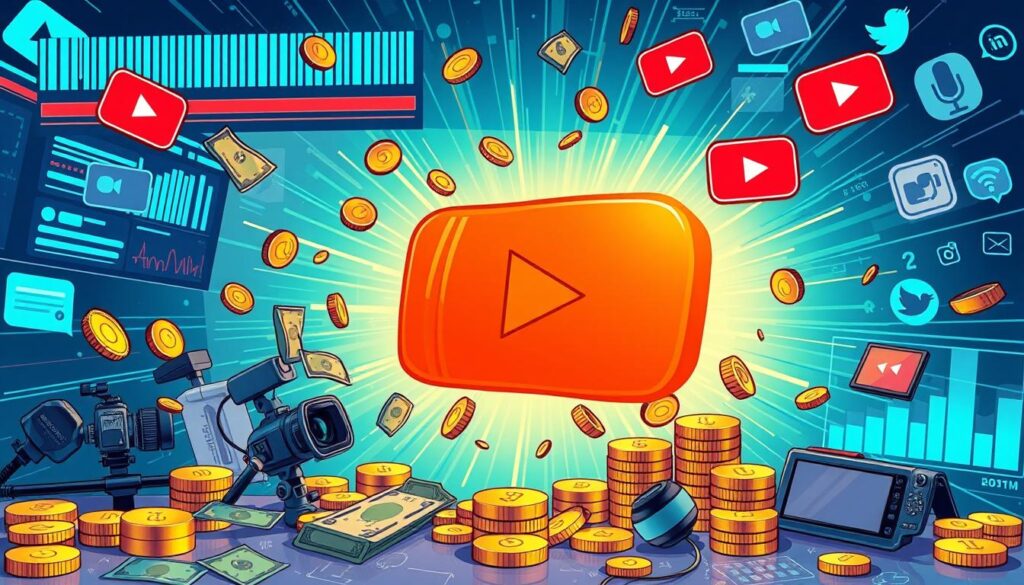The day I launched my first website, I was thrilled. I thought many visitors would come every day. But, the traffic was slow. I learned about SEO and its power to boost my site’s traffic.
SEO unlocks your site’s potential on the internet. It makes your site more visible to those searching online. I’ll show you how SEO works and why it’s key to your online success.
Today, people make over 3.5 billion searches on Google daily. SEO is vital for anyone with a website, small or big. Learning SEO basics can make a big difference in how many visitors you get.
This guide will teach you all about SEO. We’ll cover on-page and off-page strategies, how search engines operate, and the best SEO practices. You’ll be equipped to boost your site’s rank and attract more visitors by the end.
Key Takeaways
- SEO improves website visibility in search engines
- Organic traffic accounts for 53% of all website traffic
- The global SEO industry is projected to reach $122.11 billion by 2028
- Google processes over 3.5 billion searches daily
- Understanding SEO basics is crucial for online success
- SEO involves on-page, off-page, and technical optimization
Understanding SEO: The Basics
SEO, or Search Engine Optimization, is super important in the digital world. Let’s dive into what it means and why you should care.
Definition of SEO
SEO helps websites show up more in search results. This makes them easier for people and search engines to understand.

Importance of SEO for businesses
For businesses, SEO is more than important; it’s vital. It brings in long-lasting traffic and helps meet important goals. Here’s a quick look at why SEO is big:
- Organic search drives 53% of all website traffic
- The global SEO industry is forecasted to reach $122.11 billion by 2028
- 45.1% of desktop users click on organic search results, compared to only 1.8% on paid results
How search engines work
Search engines constantly work to find what you’re looking for. They do this in three steps:
- Crawling: Programs check out new pages all over the web
- Indexing: They carefully store what they find in a huge database
- Ranking: When you search, search engines show you the most helpful pages first
Knowing how search engines work helps businesses do better with SEO. For instance, focusing on specific, less-used keywords can attract more early visitors. Giving users a good experience on your site also boosts your search result position and the number of links to your site.
| SEO Component | Description | Impact |
|---|---|---|
| Content Optimization | Making important and interesting content | It makes your site more helpful and popular |
| Technical SEO | Making your site’s structure and speed better | It helps search engines understand and find you easily |
| Link Building | Getting links from trusted places | It raises your site’s status and likely ranks it higher |
Focusing on these areas, and keeping up with the latest in SEO, can really help a business be more visible online. It leads to steady growth through SEO efforts.
The Evolution of SEO
I’ve seen SEO grow from easy tricks to today’s complex system. In the early internet, SEO meant just using lots of keywords and links. Sites could cheat their way up the ranks easily.
But, search engines got smarter. They started caring more about what users wanted. This shift changed SEO a lot.

Google’s updates are a key part of modern SEO. Here are some big updates:
- Panda (2011): Targeted low-quality content and content farms
- Penguin (2012): Penalized websites with unnatural link profiles
- Hummingbird (2013): Improved understanding of search intent
- Mobile-Friendly Update (2015): Prioritized mobile-friendly websites
- RankBrain (2015): Introduced machine learning to the algorithm
- BERT (2019): Enhanced natural language processing capabilities
These changes made SEO pros focus on making great content for real people. The old days of gaming search results are over.
Search engines today care a lot about the user’s experience and quality content. Good websites offer useful info and are easy to use. They also work well on phones and load fast.
“SEO is no longer about stuffing keywords and building links; it’s about creating a great user experience and delivering valuable content.”
Soon, artificial intelligence will change how search engines work even more. Voice and visual searches are new areas to watch.
| Era | Focus | Key Tactics |
|---|---|---|
| Early 2000s | Keyword density | Keyword stuffing, hidden text |
| Late 2000s | Link building | Link farms, directory submissions |
| 2010s | Content quality | Long-form content, natural link building |
| 2020s | User experience | Mobile-first, Core Web Vitals, E-A-T |
SEO’s growth mirrors how we use the internet and tech changes. As search engines get better, SEO will keep changing. Its goal is always to help users find what they need.
Key Components of SEO
Search Engine Optimization (SEO) is a mix of different things. It works to make your website appear more often and higher in search results. There are three main parts to it we will look at closely.
On-page SEO
On-page SEO is about making each web page better for search engines. You do this by making the page:
- Crafting high-quality, relevant content
- Optimizing title tags and meta descriptions
- Using header tags (H1, H2, H3) effectively
- Incorporating relevant keywords naturally
- Optimizing images with alt text
Optimizing your pages is key. It helps search engines see why your content is right for someone’s search. A page that’s well-optimized stands a better chance of being found first in searches.
Off-page SEO
Off-page SEO is what you do outside your website that helps it get noticed more online. Things like:
- Building high-quality backlinks
- Managing online reputation
- Social media marketing
- Guest blogging
Working off your website can make it look good to others. It’s like having popular friends. The more you get noticed by other good websites, the more you can move up in search rankings.
Technical SEO
Technical SEO is about making a strong base for your website. This includes:
- Improving site speed
- Ensuring mobile-friendliness
- Creating XML sitemaps
- Fixing crawl errors
- Implementing schema markup
Having strong technical SEO means search engines love visiting your site. A site that they find easy to read and explore is likely to get better search spots. It also makes for a good visitor experience.
| Component | Focus Area | Impact on Rankings |
|---|---|---|
| On-page SEO | Content and HTML source code | Direct |
| Off-page SEO | External factors | Indirect |
| Technical SEO | Website and server optimizations | Direct and Indirect |
Focusing on these three parts makes a strong SEO plan. It can make your website better known, get more visitors naturally, and rank higher in searches.
On-Page SEO Techniques
On-page SEO is key for making your webpages do well on Google and get more people visiting. I will show you how to make your website more visible and the content better for users.
Keyword Research and Optimization
Good keyword research is the start of great SEO. I find the right words that people search for and use them naturally in the content. This lets search engines know what the page is about.
- Use keywords in title tags, headers, and meta descriptions
- Include long-tail keywords for specific queries
- Analyze competitor keywords for inspiration
Content Creation and Optimization
Making content people want to see is vital. I write unique and useful content that answers questions and use pictures to help.
- Structure content with headings (H1-H6) for easy reading
- Use internal links to improve site structure and navigation
- Add external links to authoritative sources
- Incorporate visual content like images and charts
Meta Tags and Descriptions
Meta tags are big for on-page SEO. I make catchy descriptions using key words and a clear ask for people to click. This gets more people from search results to your page.
Well-optimized meta tags can significantly impact your website’s visibility and user engagement.
URL Structure
URLs that are good for SEO are easy, clear, and right on point. I make sure the URLs use words that tell what the page is about. This helps search engines and people find your page.
| URL Type | Example | SEO Impact |
|---|---|---|
| Descriptive | /seo-techniques | High |
| Numeric | /post-12345 | Low |
| Date-based | /2023/05/seo-post | Medium |
Using these on-page SEO tricks, my site did better in search and got more visits. The trick is, offer value to users and help search engines find you easily.
Off-Page SEO Strategies
Off-page SEO deals with things outside your website to improve its online standing. It aims to make your site more trusted and visible online.
Building links from other trusted sites is key to off-page SEO. It shows search engines that your content is worth checking out. Backlinks work like votes for your site.
Social signals from sharing your content on social media are important. They help draw more people to your site. This engagement can indirectly help your search rankings.
Mentions of your brand, even without links, are positive. Search engines see these as signs that your brand is important. They might lead to new link-building chances too.
Using content wisely boosts your off-page SEO efforts. Good content can lead to natural backlinks, more brand recognition, and show your expertise.
“Off-page SEO is about more than links; it’s about making connections and showing your brand as a leader in your field.”
Let’s look at the benefits of various off-page SEO methods:
| Strategy | Primary Benefit | Difficulty Level |
|---|---|---|
| Link Building | Improves domain authority | High |
| Social Signals | Increases brand visibility | Medium |
| Brand Mentions | Enhances online reputation | Medium |
| Content Marketing | Attracts natural backlinks | High |
Boost your site’s status and attract more visitors by using these off-page SEO methods. Keep in mind, you need to be both consistent and offer high-quality content for it to work well.
Technical SEO Essentials
Technical SEO is key to how well your website shows up on search engines. I’m here to walk you through the basics. By understanding this, you can make your site much more visible and improve its position.
Site Speed Optimization
Your site’s speed is very important for people using it and how it ranks on search engines. Google gives sites a score with its PageSpeed Insights tool. This score goes from 0 to 100. To make your site faster:
- Minify HTML, CSS, and JavaScript files
- Use a content distribution network (CDN)
- Implement caching
- Optimize images
If your page loads one second slower, you could lose 90% of your visitors. This shows how crucial speed is.
Mobile-Friendliness
Now, being mobile-friendly is a must with Google. Check your site to make sure it works well on all devices. You can use Google’s Mobile-Friendly Test for this.
XML Sitemaps
XML sitemaps are like a guide for search engines, showing them around your site. They are important because they help search engines understand your website’s structure. This makes it easier for them to see your new or updated content.
Robots.txt
The robots.txt file tells search engines which parts of your site to look at. This is key for making sure they see the most important pages and not the ones that don’t matter as much.
| Technical SEO Element | Impact on SEO | Tools for Assessment |
|---|---|---|
| Site Speed | Affects user experience and rankings | Google PageSpeed Insights |
| Mobile-Friendliness | Critical for mobile-first indexing | Google’s Mobile-Friendly Test |
| XML Sitemaps | Improves crawlability and indexation | Google Search Console |
| Robots.txt | Manages crawl budget | Robots.txt Tester in Search Console |
Mastering these technical SEO basics can really boost your website. It helps with how well search engines can see your site. Plus, it raises your chances of appearing higher in search results.
SEO, Search Engine Optimization, What is SEO, SEO Guide, SEO Basics, SEO Techniq
SEO basics are key to being noticed online. Businesses know they need SEO to appear higher in search results. We’ll cover some important SEO tactics to boost your site’s success.
Good content is essential for SEO success. Surprisingly, updating old posts can be a smart SEO move, saving time and keeping your site’s search ranking up.
Here’s a quick list of SEO tricks:
- Keyword research and optimization
- On-page optimization
- Link building
- Technical SEO improvements
- Content creation and marketing
Almost all online journeys start with a search engine, 93% to be exact. This shows how vital good SEO is for drawing in visitors.
Now, some interesting SEO stats:
| Fact | Percentage |
|---|---|
| Users ignoring paid ads | 70-80% |
| Marketers prioritizing SEO | 61% |
| Users rarely clicking past first page | 80% |
| Marketers seeing SEO as more effective than PPC | 70% |
These figures show why organic search is crucial. Google, for example, looks at over 200 factors to rank sites, making SEO both challenging and rewarding.
SEO is not about tricking Google. It’s about partnering with Google to provide the best search results for Google’s users.
To sum up, by focusing on SEO basics and staying informed on new SEO trends, you can greatly increase your website’s visibility and attract more organic visitors.
White Hat vs. Black Hat SEO
In search engine optimization (SEO), we find two main tactics: White Hat SEO and Black Hat SEO. It’s important to know their differences. This knowledge helps use SEO in a way that won’t get your website in trouble with search engines.
White Hat SEO Practices
White Hat SEO is all about being ethical. It involves following the rules search engines provide. The main goal is to create value for users. This not only helps with your search ranking but also makes the internet a better place for everyone. Some examples of White Hat SEO are:
- Creating high-quality, original content
- Optimizing website structure and performance
- Building natural backlinks through valuable content
- Improving user experience and site navigation
- Using relevant keywords in a natural way
By sticking to these good practices, your website can grow safely in search. White Hat SEO is all about trust. It shows search engines you’re working to make the web better for people. And they reward that.
Black Hat SEO Techniques to Avoid
The other side is Black Hat SEO. It’s all about breaking the rules. These tricks can sometimes give your website a quick boost in searches. But, if you get caught, it can lead to big penalties. Here are a few things that fall into Black Hat SEO:
- Keyword stuffing in content and meta tags
- Creating hidden text or links
- Using automated comment spam
- Participating in link farms or buying links
- Cloaking or sneaky redirects
Black Hat SEO is risky. While it might work for a little bit, in the end, it’s not worth it. It often leads to your website doing poorly in searches or not showing up at all.
“The path to sustainable SEO success lies in ethical practices that prioritize user experience and adhere to search engine guidelines.”
If you want to do well online, I’d say to stick to White Hat SEO. Focus on making great content, improving your website, and playing by the search engine’s rules. This way, you can find long-lasting success in the SEO world.
Measuring SEO Success
Tracking SEO success helps improve strategies for lasting growth. I look at important measures and use powerful tools for analysis.
- Organic traffic
- Keyword rankings
- Click-through rates (CTR)
- Bounce rates
- Conversion rates
I use Google Analytics and Google Search Console to get data. They help see how the site is doing and what users like.
It’s vital to have clear goals for SEO success. I set specific targets that match our big business aims. This method helps us track progress and the return on our investment.
| KPI | Importance | Measurement Tool |
|---|---|---|
| Organic Traffic | High | Google Analytics |
| Keyword Rankings | High | SEO Software |
| Click-Through Rate | Medium | Google Search Console |
| Bounce Rate | Medium | Google Analytics |
| Conversion Rate | High | Google Analytics |
SEO outcomes might not show up right away. I keep an eye on progress and use data for smart changes.
“SEO is a marathon, not a sprint. Consistent effort and data-driven decision-making are key to long-term success.”
Looking at these SEO metrics and KPIs helps me see how well our efforts are working. It pushes us to better our search engine rank and website results.
SEO Tools and Resources
In my journey through SEO, I’ve found many tools. These can boost your efforts a lot. Both free and paid tools play a big role in my SEO strategy.
Free SEO Tools
Free SEO tools are great to start with. Google Search Console lets me see how my site does in searches. Google Analytics gives me insights into my visitors. And for finding good keywords, I use Google Keyword Planner.
Paid SEO Tools
When I want to step up my SEO, I use paid tools. SEMrush, Ahrefs, and Moz are my top choices. They help with detailed keyword research, looking at competition, and tracking backlinks. This data is key for a great SEO plan.
- SEMrush: Great for keyword research and competitive analysis
- Ahrefs: Excellent for backlink analysis and content research
- Moz: Useful for site audits and rank tracking
Learning Resources
SEO is always changing, so I stay informed. I use a mix of learning materials. This includes online courses, webinars, and reading industry blogs. They keep my SEO knowledge up-to-date.
| Resource Type | Examples | Benefits |
|---|---|---|
| Online Courses | Coursera, Udemy | Structured learning, certificates |
| Webinars | Moz Whiteboard Friday, SEMrush webinars | Expert insights, Q&A sessions |
| Blogs | Search Engine Journal, Moz Blog | Latest trends, case studies |
These SEO tools and resources have improved my site’s traffic and visibility. To succeed, mix the right tools with ongoing learning.
Conclusion
I’ve explored how important SEO is in today’s digital world. It’s not just a buzzword. SEO helps websites stand out and get more visitors. For example, over 90% of people choose from the first page of search results. And the top link on the first page gets about a third of all clicks.
SEO requires hard work and time. But the benefits are big and worth it. SEO makes businesses trusted, and it helps them do better than their rivals. It’s built on three important parts: making sure your website works well, what’s actually on it, and what others say about it. Things like finding the right keywords and making your site work on phones are key to climbing the search result ladder.
It’s important to keep up with SEO changes. Google is the main player, with such a big share of searches on mobile. So, by making SEO a key part of your online plans, you’re setting your business up to grow. It helps you get noticed more, improving your chances of business success.






